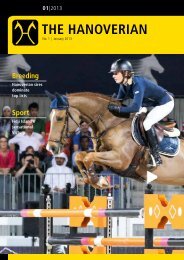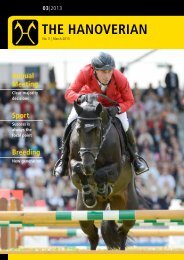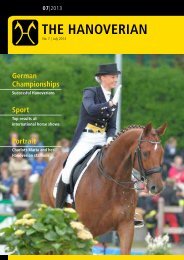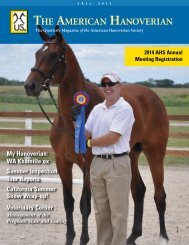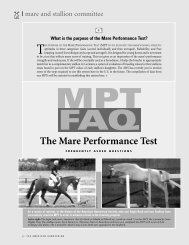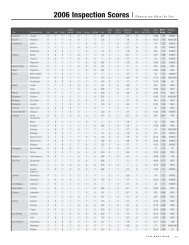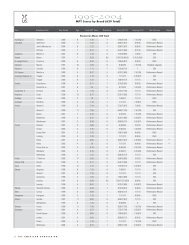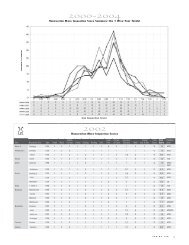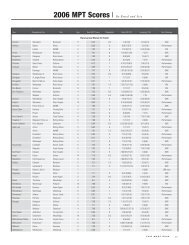The Hanoverian 08|2012 - the American Hanoverian Society!
The Hanoverian 08|2012 - the American Hanoverian Society!
The Hanoverian 08|2012 - the American Hanoverian Society!
You also want an ePaper? Increase the reach of your titles
YUMPU automatically turns print PDFs into web optimized ePapers that Google loves.
Breeder‘s portrait<br />
Ahead of<br />
his time<br />
Horses have been bred at <strong>the</strong> Klintworths in<br />
Ohrensen near Bargstedt for at least four<br />
generations. <strong>The</strong> Klintworths breed <strong>Hanoverian</strong>s<br />
in accordance with <strong>the</strong> region.<br />
By Jürgen Stroscher<br />
Grandfa<strong>the</strong>r Martin Klintworth on<br />
Sportlitze in 1950.<br />
18 <strong>The</strong> <strong>Hanoverian</strong> <strong>08|2012</strong><br />
Martin is <strong>the</strong> first name of great-granddad,<br />
granddad and dad Klintworth. <strong>The</strong> 50-year<br />
old farmer broke <strong>the</strong> tradition and named his oldest<br />
son Ole (now 15 years). None-<strong>the</strong>-less Ole<br />
plans to take over <strong>the</strong> family business one day.<br />
“My granddad and my dad were on <strong>the</strong> track of<br />
today’s modern sporthorses very early on. Both<br />
competed our mare Sportlitze very successfully in<br />
jumping competitions up to <strong>the</strong> S-level during <strong>the</strong><br />
fifties and <strong>the</strong> sixties,” Martin Klintworth shares.<br />
Today’s damline traces back to <strong>the</strong> producer Sporno<br />
by Sportanzeiger II. <strong>The</strong> line is named after <strong>the</strong><br />
homebred mare Kurflamme, born 1959, by Kurland<br />
II. Although her dam Sportlitze by Sporno is considered<br />
<strong>the</strong> founder of today’s breeding program of<br />
Family Klintworth.<br />
Sporno was known for his good jumping ability. In<br />
his time he was very popular with <strong>the</strong> breeders<br />
from <strong>the</strong> Elbe region. “One of his descendants was<br />
our chestnut mare Sportlitze. She was very big and<br />
her exterior did not at all correspond with <strong>the</strong> exterior<br />
of workhorses. Luckily my grandfa<strong>the</strong>r<br />
quickly realized <strong>the</strong> capabilities of <strong>the</strong> mare and<br />
did not sell her. He used her in competition and in<br />
his riding horse breeding program instead.” Her<br />
full-bro<strong>the</strong>r Scambolo was sold however and participated<br />
in German Championships several times<br />
with his riders Peter Schmitz and Karl Heinz Giebmanns.<br />
It was this rider Scambolo won a bronze<br />
medal with in 1963. <strong>The</strong> Klintworths did not only<br />
have a good sense for breeding horses; <strong>the</strong>y also<br />
had <strong>the</strong> talent to ride. Until today <strong>the</strong>y apply <strong>the</strong><br />
following principle to <strong>the</strong> sale of horses, “I only sell<br />
horses I have trained and ridden. , I can only <strong>the</strong>n<br />
stand behind <strong>the</strong> quality of my horses with a good<br />
conscience. That is <strong>the</strong> way it always has been in<br />
our family since generations.” Family Klintworth is<br />
Silke, Janina and Martin Klintworth.<br />
also partial to jumping which reflects in his breeding<br />
goal. “Great jumping ability distinguishes all<br />
our breeding horses; good rideability is important<br />
for competition suitability at <strong>the</strong> same time.”<br />
Best prerequisites<br />
In general all foals are raised in <strong>the</strong> home barn of<br />
Family Klintworth. <strong>The</strong> horses enjoy a healthy and<br />
horse-friendly upbringing on spacious fields. <strong>The</strong>y<br />
grow up separated by age and sex under <strong>the</strong> best<br />
conditions. For example more than 20 hectares are<br />
available for colts/stallions to roam around on. Depending<br />
on ability colts are presented at <strong>the</strong> licensing;<br />
mares complete mare inspections and mare<br />
performance tests before <strong>the</strong>ir training is continued.<br />
Mares that receive <strong>the</strong> state’s premium award<br />
are earmarked for breeding. <strong>The</strong>y must prove<br />
<strong>the</strong>mselves in jumper horse classes beforehand<br />
though. <strong>The</strong> horses are are up for sale once <strong>the</strong>y<br />
are four or five years of age. Generally <strong>the</strong> vintages<br />
in that age group are marketed and sold. “If you by<br />
a horse from me you get one that has participated<br />
in jumper horse classes at <strong>the</strong> A- or L-level; in o<strong>the</strong>r<br />
words <strong>the</strong> horses I sell are in training. <strong>The</strong>refore<br />
also renowned riders like Carsten-Otto Nagel or<br />
Sören von Rönne come to us when looking for a<br />
rising youngster with potential.”<br />
For decades Martin Klintworth has afforded<br />
himself <strong>the</strong> luxury of keeping one or two suitable<br />
jumper horses for his own use. His fa<strong>the</strong>r had already<br />
granted him this privilege. His serious jumper<br />
career began at <strong>the</strong> age of eighteen. He competed<br />
<strong>the</strong> seven-year old homebred Weinstein by Wiesenbaum<br />
xx in his first S-level jumper class on <strong>the</strong><br />
Dobrock. Martin Klintworth competed a number of




